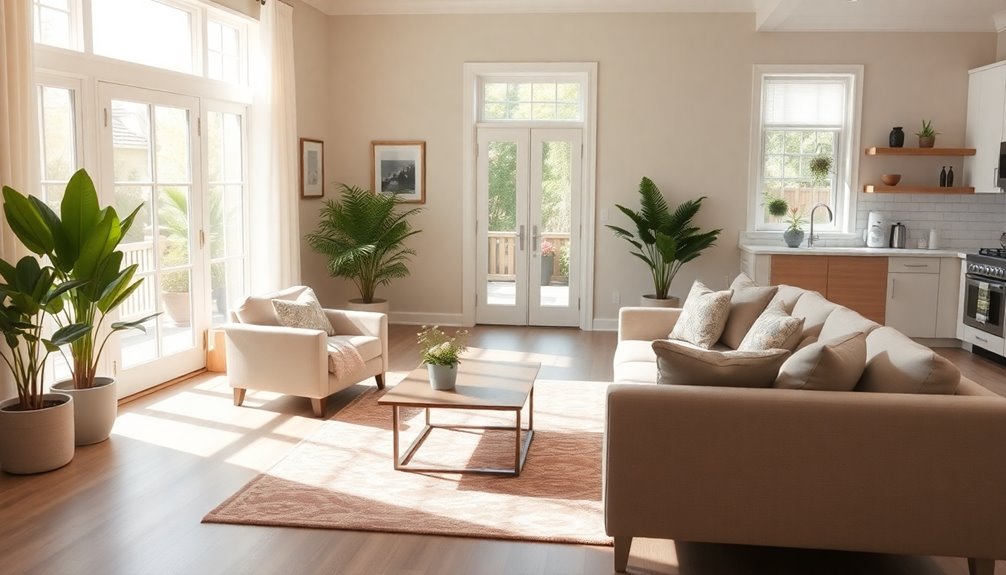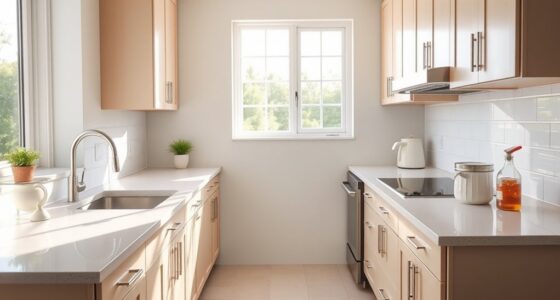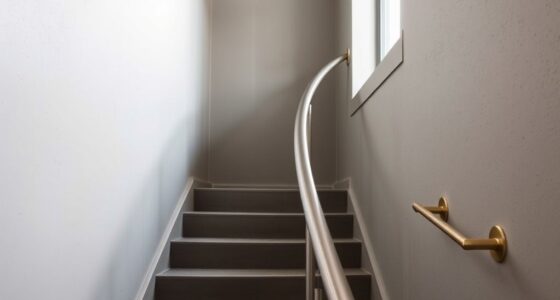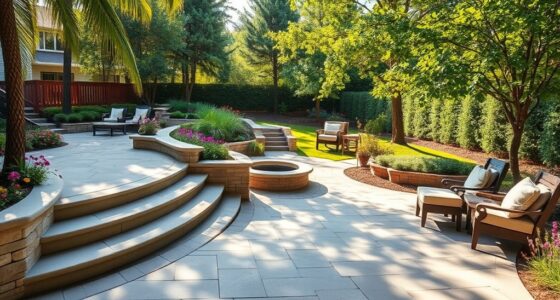To create a home that supports effortless aging in place, start with key design principles like wide doorways and step-free entryways. Guarantee safety and comfort by using slip-resistant flooring and installing grab bars. Optimize kitchens with lower countertops and pull-out shelves for easy access. Adjust bed heights and enhance outdoor spaces with wide, accessible paths. Incorporating these changes can transform your living space, making it safer and more functional. Discover additional tips to refine your home further!
Key Takeaways
- Ensure doorways are at least 36 inches wide for easy access with mobility aids, enhancing overall accessibility in the home.
- Install functional handrails on both sides of stairs, positioned 34 to 38 inches high, for added safety and support.
- Opt for slip-resistant flooring throughout the home to minimize fall risks, especially in high-traffic and wet areas.
- Incorporate adjustable lighting and motion-activated fixtures to improve visibility and enhance safety during nighttime navigation.
- Modify kitchen and bathroom spaces with lower countertops, grab bars, and walk-in showers to promote ease of use and prevent falls.
Understanding Aging in Place

As you consider the concept of aging in place, it's essential to recognize that this approach allows older adults to live independently in their own homes while maintaining their quality of life.
The design principles for aging in place focus on creating environments that prioritize safety, accessibility, and comfortable living. By implementing thoughtful home modifications, you can greatly reduce risks, such as falls, which are a leading cause of injury among seniors.
Features like non-slip flooring, grab bars, and proper lighting can enhance safety. Collaboration with professionals skilled in universal design can further optimize your space, ensuring it meets individual needs while remaining aesthetically pleasing.
Ultimately, aging in place empowers older adults to thrive in familiar surroundings.
Key Design Principles for a Safe Home

Creating a safe home for aging in place involves understanding key design principles that prioritize safety, accessibility, and comfort.
To enhance safety, eliminate hazards like loose rugs and cluttered walkways, reducing fall risks. Accessibility is vital; make certain your doorways are at least 36 inches wide and use lever-style door handles for ease of movement.
For comfort, opt for soft, low-pile carpeting and adjustable lighting to create a welcoming atmosphere. Promote independence by adding grab bars in the bathroom and kitchen, along with motion-sensor lighting to guide you at night. Additionally, consider incorporating air purifiers to improve indoor air quality, which can further enhance overall well-being.
Finally, embrace adaptability, designing spaces that can evolve with your changing needs, like open floor plans that allow for easy reconfiguration.
Prioritizing these principles helps you age comfortably at home.
Creating Accessible Entryways and Doorways

When you're creating accessible entryways and doorways, it's essential to think about step-free access.
Make sure your doorways are at least 36 inches wide to accommodate mobility aids, and consider installing functional handrails for extra support.
These simple design choices can greatly improve safety and ease of movement for everyone. Additionally, incorporating security lighting can enhance visibility and deter potential intruders, further increasing safety in the home.
Step-Free Access Solutions
Many homeowners overlook the importance of step-free access, yet it plays an essential role in ensuring everyone can enter and move around their home comfortably.
To create an inviting environment, consider these solutions:
- Implement a zero-step entry to eliminate thresholds, allowing seamless movements between indoor and outdoor spaces.
- Install ramps with a slope of 1:12 or lower to accommodate those facing mobility challenges.
- Use lever-style door handles instead of traditional knobs for easier operation with limited grip strength.
- Add handrails on both sides of ramps to enhance safety and provide support during changes.
Additionally, consider the value of financial planning to ensure that modifications fit within your budget while enhancing accessibility.
Wide Doorway Specifications
Wide doorways are essential for guaranteeing accessibility in your home, especially for those using wheelchairs or other mobility aids. The recommended minimum width for doorways is 36 inches. This allows comfortable passage without obstruction, enhancing traffic flow and reducing fall risks.
When you design or modify doorways, consider using lever-style handles instead of traditional knobs, as they're easier to operate for individuals with limited hand strength. Additionally, guarantee doorways are free of thresholds or have low-threshold designs to minimize tripping hazards.
Installing automatic door openers can further enhance accessibility, providing added convenience and independence for those with mobility challenges. By focusing on these specifications, you create a safer and more welcoming environment for everyone. Furthermore, HEPA filtration can improve indoor air quality, benefiting those with respiratory issues often faced by aging individuals.
Functional Handrail Design
Functional handrails play an essential role in guaranteeing safety and accessibility in your home, especially in entryways and staircases.
For effective functional handrail design, consider these key safety features:
- Install handrails on both sides of staircases and in hallways, ideally 34 to 38 inches high.
- Choose a diameter between 1.25 to 2 inches for a comfortable grip, using non-slip materials for enhanced safety.
- Guarantee the handrail extends at least 12 inches beyond the top and bottom steps for added support.
- Securely anchor handrails to the wall, keeping the spacing no greater than 1.5 inches to allow for a firm grasp.
Incorporating features like geothermal heat pumps can improve indoor comfort while ensuring a safe and accessible living environment.
Designing Safe and Functional Living Spaces

When designing safe and functional living spaces, you should prioritize safety and accessibility.
Consider open floor plans and slip-resistant flooring to create a hazard-free environment.
Incorporating features like grab bars and adequate lighting not only enhances comfort but also makes daily activities easier and safer. Additionally, integrating a home security system can provide peace of mind and added safety for older adults living independently.
Safety First Approaches
Creating a safe living space is essential for older adults, as it directly impacts their independence and well-being.
Prioritizing safety first helps minimize falls and injuries. Here are four vital design tips:
- Install non-slip flooring in high-traffic areas to create a stable walking surface.
- Incorporate grab bars in bathrooms and near entryways to provide essential support during daily activities.
- Ensure adequate lighting, including motion-sensor options, to improve visibility and reduce accident risks.
- Opt for open floor plans that eliminate obstacles, allowing easy movement and reducing tripping hazards. Additionally, consider incorporating protein-rich breakfast options to support overall health and energy levels.
Enhancing Accessibility Features
To guarantee that living spaces cater to the needs of older adults, enhancing accessibility features is essential.
Start by creating open floor plans with at least 36 inches for doorways and 48 inches between cabinets and islands, allowing easy maneuverability. Use slip-resistant flooring materials like cork or rubber to prevent falls, a leading cause of injury among older adults.
Installing grab bars and handrails in bathrooms and hallways provides critical support for those with mobility challenges. Additionally, consider adjustable countertops and cabinets to accommodate varying heights.
Finally, make sure there's ample lighting in transition areas and high-traffic zones to enhance visibility and reduce accidents, as vision may decline with age. Regular home cleaning is also crucial, as it supports a healthier lifestyle by promoting cleanliness and hygiene, which can further enhance safety for older adults.
Prioritizing these elements will make a significant difference in daily living.
Comfort and Convenience Elements
While comfort and convenience are essential for any living space, they become even more important for older adults who may face mobility challenges.
To create a safe and functional environment, consider these elements:
- Adjustable Furniture: Height-adjustable tables and supportive chairs enhance comfort and cater to various mobility needs.
- Open Floor Plans: Minimizing obstacles promotes ease of movement, reducing fall risks.
- Non-Slip Flooring: Materials like cork or rubber enhance safety, preventing slips while cushioning joints.
- Strategic Lighting: Motion-activated and layered lighting improves visibility, making it easier to navigate spaces safely.
- Accessible Toilets: Incorporating dual-flush toilets can enhance usability while promoting water efficiency.
Kitchen Modifications for Ease and Safety

Making your kitchen age-friendly is essential for ensuring ease and safety as you or your loved ones navigate daily tasks.
Start by lowering countertop heights to 28-30 inches for better accessibility, making food prep simpler.
Install pull-out shelves and drawers to reduce bending and reaching, minimizing strain.
Choose slip-resistant flooring materials like cork or rubber to prevent falls, creating a safer environment.
Incorporate multiple light sources, such as under-cabinet lighting, to illuminate workspaces effectively, as vision may change with age.
Finally, consider hands-free faucets with anti-scald features for added convenience and safety, allowing you to operate the sink without twisting knobs, which helps minimize the risk of burns and spills. Additionally, using natural materials in your kitchen design can enhance warmth and comfort, contributing to a more inviting atmosphere.
Bathroom Design for Accessibility
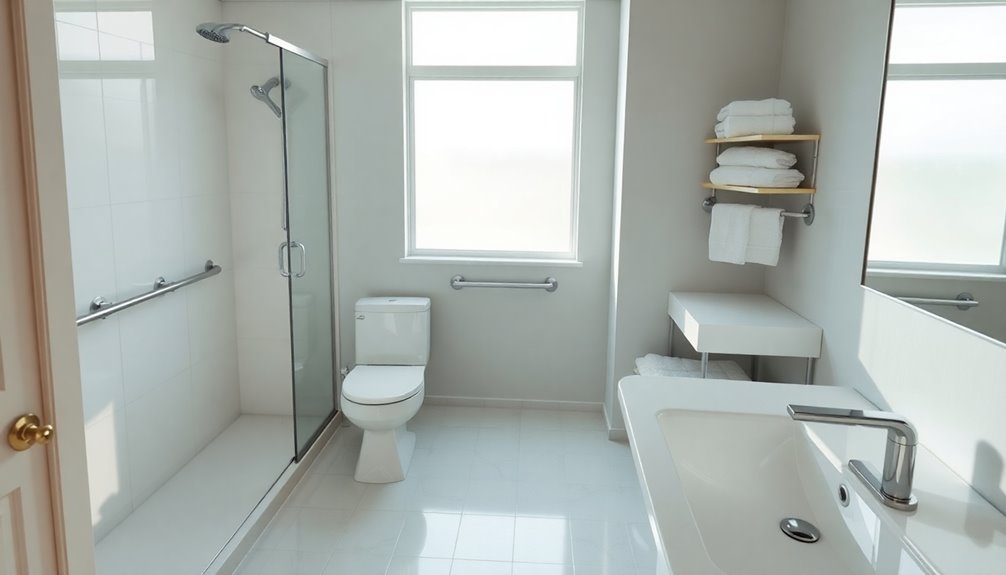
As you focus on creating a safe and accessible kitchen, don't overlook the bathroom, which can present unique challenges for individuals with limited mobility.
Effective bathroom design for accessibility is essential for maintaining independence. Here are some key features to take into account:
- Walk-in showers with low thresholds to prevent tripping hazards.
- Grab bars installed near the shower and toilet for added support.
- Non-slip mats and textured flooring to reduce slip risks in wet areas.
- Handheld showerheads for easy maneuverability, especially for those who prefer sitting while bathing.
Incorporating these elements can greatly enhance safety and comfort, allowing you to enjoy your space without worry.
Bedroom Considerations for Comfort and Functionality
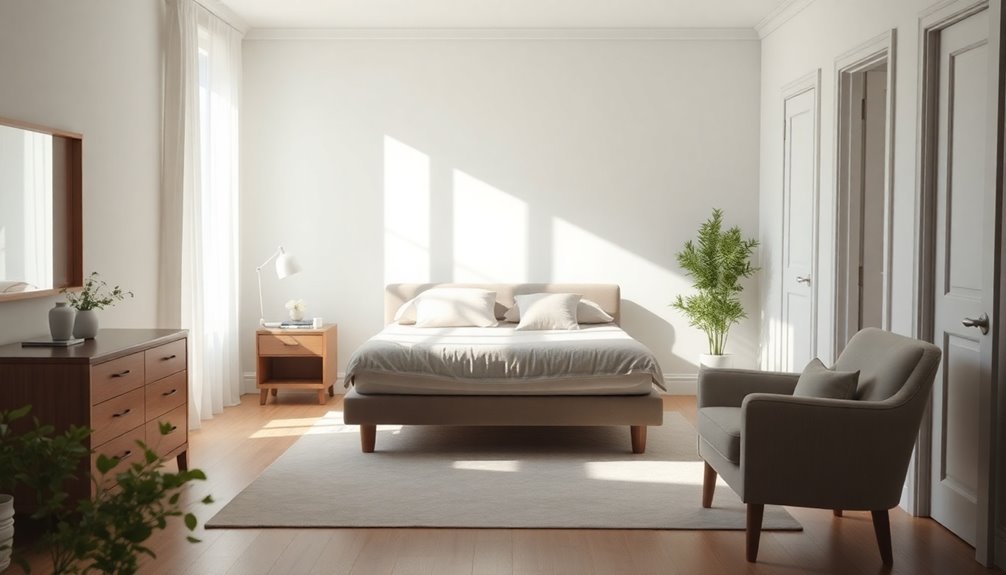
When it comes to bedroom comfort and functionality, adjusting bed height can make a world of difference in how easily you get in and out of bed.
Accessible storage solutions, like low-hanging rods and pull-out shelves, can also streamline your daily routine and reduce strain.
Let's explore how these adjustments can enhance your bedroom experience.
Bed Height Adjustments
Finding the right bed height is essential for guaranteeing comfort and safety in your bedroom, especially as you age.
Proper bed height adjustments can make a significant difference in your daily routine. Here are some key considerations:
- Aim for a bed height between 18 to 24 inches for easy entry and exit.
- Consider an adjustable bed for customizable elevation, enhancing your comfortable sleep quality.
- Install bed rails for added support when moving between standing and sitting.
- Verify at least 24 inches of clearance on both sides for mobility aids and easy access to essentials.
Accessible Storage Solutions
Creating a comfortable and functional bedroom goes beyond just the right bed height; accessible storage solutions play a key role in enhancing your daily living experience.
Incorporating lower hanging rods in your closet at 48 inches or lower guarantees easy access to clothing without straining. Using pull-out shelves and drawers in your furniture allows you to reach items without bending or stretching, reducing stress during daily tasks.
Organizing your belongings in clear containers improves visibility, making it easier to find what you need. Strategically placing sturdy seating in your closet provides support while dressing.
Finally, having nightstands with accessible drawers keeps essential items like medications and reading materials within easy reach, boosting overall functionality in your bedroom.
Hallway and Stair Safety Features

Hallways and stairs are critical areas in a home that require thoughtful safety features to prevent accidents and enhance accessibility.
Here are four essential tips to improve hallway and stair safety:
- Guarantee hallways are at least 36 inches wide to accommodate mobility aids and guarantee easy movement.
- Install handrails on both sides of stairs to provide essential support, reducing fall risks.
- Use non-slip treads or strips on stairs for better traction, especially in high-traffic areas.
- Incorporate adequate lighting, including motion-sensor options, to enhance visibility during nighttime navigation.
Enhancing Outdoor Spaces for Wellness

Safety features indoors set the stage for enhancing outdoor spaces that promote wellness. You can create inviting environments by focusing on accessibility and comfort. Confirm pathways are at least 36 inches wide, made of non-slip materials, and add good lighting, like motion-sensor lights, to boost safety during evening hours. Consider comfortable seating areas with shade for relaxation and social interactions.
Here's a quick overview of essential outdoor features:
| Feature | Benefits |
|---|---|
| Non-slip pathways | Prevent trips, accommodate aids |
| Comfortable seating | Encourage relaxation, socializing |
| Raised garden beds | Promote gardening without bending |
| Accessible features | Improve safety and mobility |
Incorporating these elements will greatly enhance your outdoor spaces.
Integrating Technology for Improved Living

As technology continues to evolve, it offers innovative solutions that can greatly improve the quality of life for seniors.
Integrating smart home technology is an effective way to enhance safety and promote independence for aging adults. Here are four key elements to evaluate:
- Voice-Activated Controls: Manage lighting, temperature, and security effortlessly with voice commands or smartphone apps.
- Telehealth Services: Consult healthcare providers remotely, making medical care more accessible.
- Wearable Devices: Use fitness trackers to monitor health metrics, keeping you informed and supported.
- Fall Detection Systems: Implement sensors that alert emergency contacts in the event of a fall, ensuring a quick response.
These technologies can markedly enhance daily living, making aging in place both easier and safer.
Frequently Asked Questions
How to Design for Aging in Place?
To design for aging in place, you'll want to create open spaces that promote easy movement.
Use slip-resistant flooring to minimize fall risks, and incorporate adjustable countertops to suit various needs.
Make certain your home has adequate lighting with accessible switches to enhance visibility.
Finally, install safety features like grab bars and lever-style door handles, which make daily tasks easier and safer for everyone, regardless of age or ability.
What Is the Best Home Design for Aging in Place?
The best home design for aging in place focuses on safety and accessibility.
You'll want wide doorways and open floor plans to make movement easier. Choose non-slip flooring to reduce fall risks, and lower gloss surfaces to improve visibility.
Smart home technology, like automated lighting, can enhance your independence.
In the bathroom, consider walk-in showers and grab bars for safety.
Proper lighting placement in crucial areas can also help you navigate safely.
How to Successfully Aging in Place?
Aging in place? Oh, what a delightful fantasy! You might think it's all about knitting and reminiscing, but it's really about transforming your home into a fortress of safety and convenience.
You should ditch those tripping hazards, install grab bars, and brighten up those dark corners. Embrace smart tech for ease, and guarantee your kitchen and bathroom are user-friendly.
Regularly reassess your space, because your needs will change faster than your favorite TV shows!
What Is a Universal Design for Aging in Place?
Universal design for aging in place focuses on creating spaces that everyone, regardless of age or ability, can navigate comfortably.
You'll find features like zero-step entrances and wide doorways that make movement easier. Lever-style handles enhance accessibility, while adjustable elements allow your home to adapt as your needs change.
Conclusion
By implementing these age-friendly design tips, you can create a safe and comfortable environment that supports your independence as you age in place. For instance, consider the case of Mrs. Thompson, who modified her bathroom with grab bars and a walk-in shower, allowing her to maintain her daily routine without fear of falling. Embrace these changes today, and you'll enjoy a home that adapts to your needs, enhancing both your safety and quality of life.
